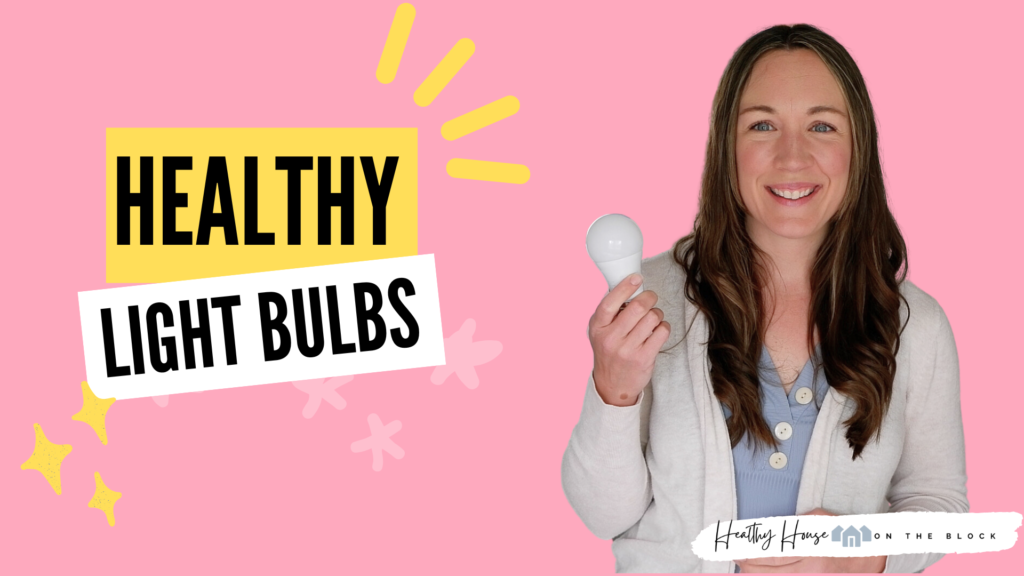
One of the toxins within our home that we don’t always hear about is the toxic exposure that comes from our electricity. Quite often, many of us don’t fully understand electricity, and so it’s easier to ignore it’s potentially harmful effects on our bodies and home. Those potentially harmful components come from what’s called “dirty electricity”, which is in every home.
This is also why it’s so important to make healthier choices where we can in order to avoid this phenomenon of dirty electricity. Light bulbs are one of the simplest things we can change throughout our home. Not only are they available readily at most hardware stores, they are something most of us can swap out on our own without any trouble.
You know, I’m a huge proponent of changing whatever you can and simply not worrying about the rest. There’s no use in worrying about dirty electricity that you can’t change, such as that from permanent sources outside your home. Inside your home, however we can make some really simple changes that can prevent dirty electricity from affecting our bodies.
WHAT IS DIRTY ELECTRICITY?
And another thing I’m BIG on is understanding a particular toxin and source of a particular toxin. And while yes, you could just skip to the end to find out what the safest light bulb to use. But I also wanted to give you the option to fully understand dirty electricity and what it is within your home.
Dirty electricity is the phenomenon that occurs when normal flow of alternating electrical current is disrupted, causing electrical surges and irregular spikes along the wires. When the dirty electricity intensifies to a higher frequency, it can spread to more areas, creating more potential harm.
Most homes operate using 60 Hertz AC (which stands for alternating current). This means that the current changes 60 times per second back and forth. It changes from positive to negative and from negative to positive 60 times per second.
What happens is many of our electronics call for more, less or even an adjustable amount of electricity, which is not how our systems of 60 hertz AC were designed to be used. Currents of electricity then gets trapped inside the electrical lines because of these devices manipulating the amount of power.
This process interrupts the smooth flow of electricity, and instead creates a big problem. The electricity spikes and surges through the line, which is essentially what dirty electricity is or electrical noise.
Unstable electricity that gets trapped in the wiring of the home. This in turn produces measurable amounts of electromagnetic radiation (EMF).
What’s more is that some of the light bulbs and light bulb components that we use, like dimmer switches also create dirty electricity within our wiring. (Dirty Electricity Information)
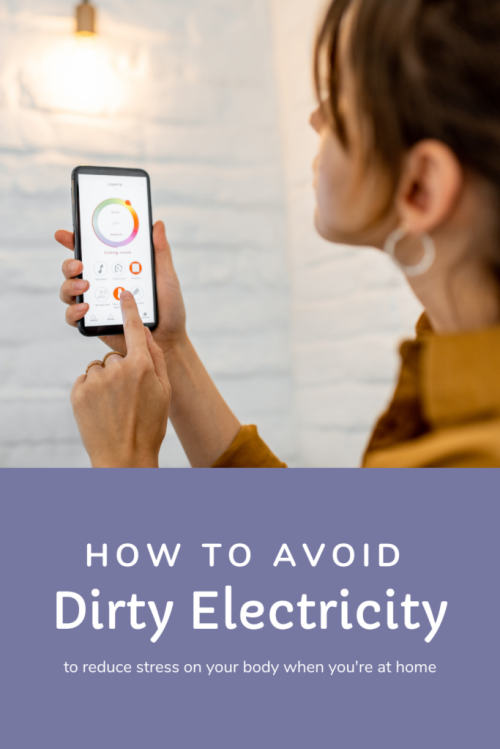
WHAT ABOUT LIGHT BULBS?
I mentioned it before, but light bulbs can be a source of dirty electricity within our homes. But, with that being said, not all light bulbs are created equal. Here’s a breakdown of the typical types of light bulbs we purchase for our homes and the benefits and downfalls to each one in terms of dirty electricity.
LED Light Bulbs: Often LED light bulbs give off a blue tint, which in terms of our health, is hard on our eyes and can actually increase the risk of cataracts. (Cataract Study). The blue light also suppresses melatonin production, which as you may know is the hormone in charge of regulating the quality of sleep you get.
LED light bulbs most often run on direct current, which we established above is one of the largest causes for dirty electricity and EMF radiation within the home. LED light bulbs alternate the frequency of alternating current (AC) to direct current (DC), which backfeeds small amounts of electricity into the incoming power line. This disruption produces dirty electricity within our own home.
This comparison chart from Healthy Building Science can help you see the vast difference in types of LED light bulbs.

CFL Light Bulbs (compact fluorescent): Those curly, fluorescent light bulbs are one of the most popular types of light bulbs out there due to their low cost and availability. Most of us have these somewhere in our home and they’ve become a standard as they replaced the older style incandescent light bulbs.
Unfortunately, the CFL light bulbs most of us use are one of the worst light bulbs to have in our homes for a variety of reasons.
First, in terms of dirty electricity, CFLs use high frequency electricity instead of the 60 Hertz that many of our homes have. Compact fluorescent bulbs change the AC current we use to DC, which creates those spikes and surges in our power that I mentioned earlier. These surges and spikes emit high amounts of EMF radiation (EMF and CFL Study).
Basically, our electrical systems were not made to handle the high frequency demands of CFL light bulbs, and as they produce dirty electricity within our homes, they also produce EMF radiation as the dirty electricity builds up in our wiring.
Another reason to avoid CFL light bulbs is due to the UV light that is produced from these types of bulbs. The ultraviolet light that compact fluorescent bulbs produce can be linked to skin and cell damage within our bodies. (UV and CFL Study)
Fluorescent: While most of us no longer have fluorescent light bulbs in our homes, there are some out there and you can still purchase them. In addition, most office spaces and buildings still use fluorescent light bulbs.
Fluorescent light bulb problems are very similar to that of CFL light bulbs, just on a grander scale. Fluorescent light bulbs give off high levels of magnetic fields up to 18 inches from their coils.
Fluorescent light bulbs have also been linked to an increased risk of malignant melanoma in those who are frequently exposed. (Fluorescent light bulb study about melanoma)
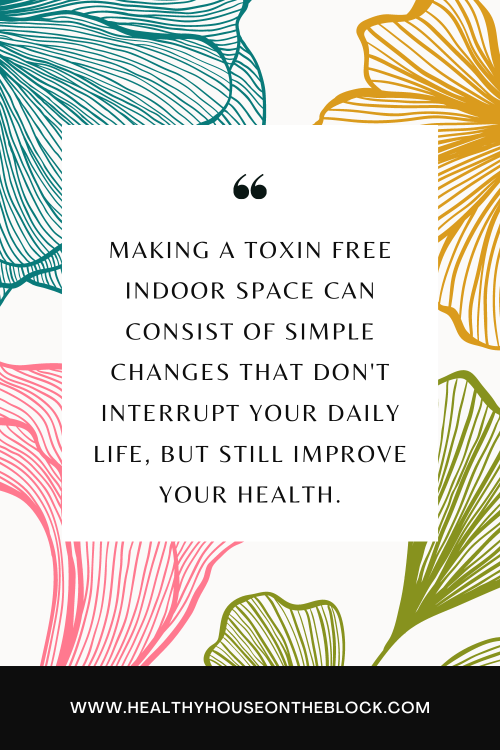
Incandescent Light Bulbs: Incandescent light bulbs are definitely a thing of the past, and it can be very difficult to find them anymore. While they are one of the safest light bulbs because they use our home’s AC current, they are also the least efficient in terms of energy use.
Incandescent light bulbs are less efficient because the energy coming from the wires has to heat up the filament instead of produce light, which causes it to use vastly more energy than other types of light bulbs.
The light that is produced with incandescent light bulbs is also a more natural hue of light, not a blue tinted light like newer LED and CFL bulbs.
Halogen lights are also in the same category as Incandescent light bulbs. However, instead of argon gas, which incandescent light bulbs use, they use halogen gas. The halogen gas generally requires and produces more heat, however they typically last longer than incandescent lights.
Because incandescent bulbs are the simplest design, they are also the lowest EMF bulbs you can find. There’s no RF radiation that comes from these bulbs and the design often matches the wiring in most homes.
HOW LIGHT BULBS (AND DIRTY ELECTRICITY) AFFECT OUR HEALTH
So let’s talk about EMFs (electric and magnetic fields) and your health. First, it’s important to know that EMFs are everywhere, and are naturally occurring within the earth and our world.
The harm of EMF exposure comes in the frequent contact we have with them within our homes and the strength of them produced by electronics and appliances within our homes.
Sources of EMF radiation in our homes vary in strength, but those emitting the most dangerous EMF radiation include our cellphones, televisions, microwaves, computers and Wi-Fi devices.
Studies continue to be done on EMF radiation, but it has been established as a possible carcinogen to the human body (Study).
The World Health Organization has also reported biological harm to humans from increased exposure to EMF radiation including fatigue, headaches, mood swings, asthma, fertility issues, digestive issues, memory problems, sleep issues.
In addition to these problems, another study linked chronic diseases such as cancer, heart problems, alzheimers and diabetes to EMF radiation as well. (Study)
Dirty electricity, which produces EMF radiation within our homes and within our wiring has been studies, showing effects on the body including diabetes and multiple sclerosis: (Study)
This post about creating a sleep sanctuary talks about how EMF radiation is particularly important to avoid in bedrooms.
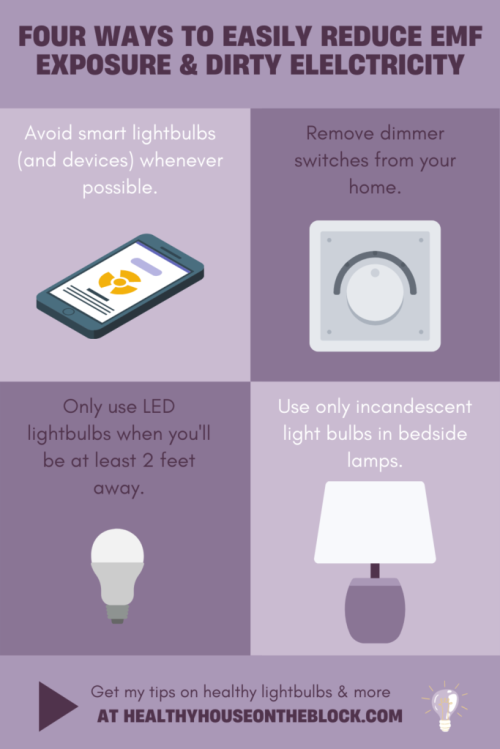
HEALTHIER OPTIONS FOR LIGHT BULBS
There are options to filter out the dirty electricity, but I think first and foremost the best solution is to reduce the dirty electricity producing devices.
1. Avoid Smart Light Bulbs wherever you possibly can. Smart light bulbs generate radiofrequency (RF) radiation, This is the same type of radiation that emits from cell phones and tablets and is extremely impactful to our health and wellness.
2. Remover Dimmer Switches if you can. I too love low light and ambience, but dimmer switches are a recipe for high levels of EMF exposure and dirty electricity. The light switch calls for varying levels of electrical current, which causes the electricity to spike and surge as it gets trapped.
3. Be Smart About LED Lights. The one thing we know about LED lights is that it causes high levels of dirty electricity and EMF exposure in your home. But I also understand that some options like can lights and strip lighting is only available in LED form. The best practice is to use LED lights in places where you won’t be sleeping and you’ll be at least 2 feet away from the light bulb. EMF radiation drops off relatively quickly the farther away you get from the device, which can help you decide on where t put them.
4. Use Incandescent Lights in Bedside Lamps. The best way to reduce EMF exposure is to focus on where you sleep. Any light bulbs that are in bedside tables will be near your head as you sleep all night long. Make sure these lights are incandescent bulbs which give off very little to no EMF radiation, which will protect you while you sleep.
HEALTHY LIGHT BULB TOP PICKS
The good news is that there are healthier light bulbs to choose that produce less or no dirty electricity within our homes. What’s even better is that it’s a simple change to make that we will likely not even notice once we’ve made it.
Share this:
- Click to share on Facebook (Opens in new window) Facebook
- Click to share on LinkedIn (Opens in new window) LinkedIn
- Click to share on Reddit (Opens in new window) Reddit
- Click to share on Pinterest (Opens in new window) Pinterest
- Click to print (Opens in new window) Print
- Click to share on X (Opens in new window) X


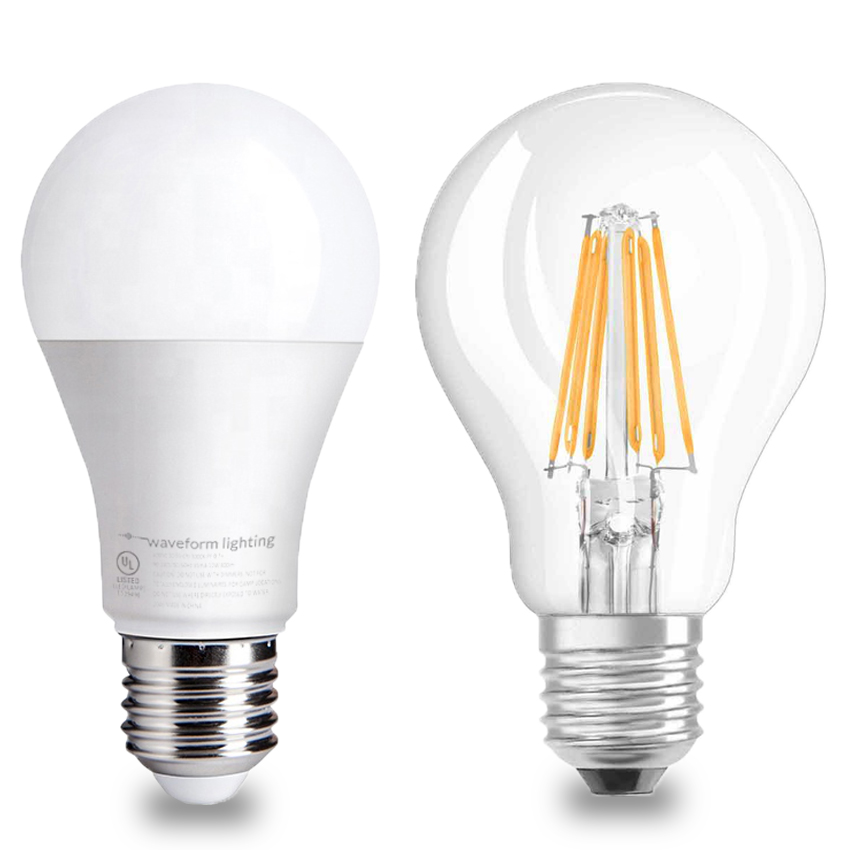





Wow I never gave a thought to how light bulbs could be effecting me! Super informative thank you! I know I have a lot of the swirling lightbulbs I guess I may have to look at switching them out!
Impressive research that I will bookmark for later use, once we decide to change all light bulbs in our house. Thanks
Hi, Amanda! Thanks for this great post! I’m wondering if you have any recommendations for types of LED can lights, or what kind we should ask our electrician for. My electrician is telling me that the can lights he’s installing in my new home are one-piece, meaning you replace the whole thing, not a bulb. I guess it’s a new thing? In my current home I can just unscrew bulbs and replace them in my can lights. Since I’m limited to what he’s already installed, is there anything I can ask for that will be a healthier option than a standard LED? I know I can pick color/hue, but I don’t know what question to ask as far as what he might have available.
Hi Carol! Thanks for the question! These can lights are a great option (low EMF exposure, no UV light, no mercury, etc.): https://www.greenbuildingsupply.com/All-Products/Energy-Water-Air-Lighting/MaxLite-LED-Faux-Can-Light-4-Dimmable-Wet-Listed. Let me know if this is what you were looking for.
Hi Amanda! I have been suffering from migraines and tinnitus ever since we “smart enabled” our lighting. I have tried everything and recently read about EMF. I purchased an EMF meter and tested my home. I made many changes immediately, but getting incandescent bulbs was an online thing, so I only ordered two replacements to test, and am hoping for advice before I redo the whole house… I bought Edison 60W Incandescent and Xtricity 40W incandescent, however, when I test my currently installed LEDs I get about 80V/m but when I use the incandescent it actually increases… which was unexpected. I was hoping to reduce. The Xtricity is is 90V/m and the Edison was over 550V/m!!! I want to make the best choice but now I am confused. Help?
HI Candice! Make sure you’re not using any dimmable lights — these are the worst. Try to find a 50hz incandescent light bulb if you can. Otherwise, this website should be able to help you: https://healthybuildingscience.com/2017/06/05/dirty-electricity-leds/
Hi Candice, I was just reading your concerns about the high readings of EMF V/m with your new incandescent bulbs. So, what you are actually measuring is the electric field not the dirty electricity, and because the incandescent bulbs run off the normal 110v power supply you will always have a larger electric field compared to LED’s which use a switch mode power supply (driver/transformer) to step the power down to 12-24v. As long as you are not in the electric field you will be fine, and as this website says…you will benefit from the incandescent bulbs because they provide a similar spectrum to sunlight and less harmful blue light than standard LED’s. The dirty electricity is created when the electricity is converted from 110v to 12/24v for the LED lighting but you can not measure this with your EMF meter. The best lights will be red incandescent lights for the bedrooms and amber lights for reading, and lights that emit more blue light can be used in a home office and gym to enhance wakefulness.
Hi Amanda, thanks for this article. Where did you find the info about the recommended light bulb sources? I I can’t find any additional resources about those leds being low emf or ac.
Hi Eileen! Thanks for the comment! Here’s a helpful chart that I found about these light bulbs: https://healthybuildingscience.com/2017/06/05/dirty-electricity-leds/
Hi. Thanks for the helpful info! Reviewing the chart linked, it looks like Cree bulb produces a lot of dirty electricity. Wondering how you concluded it was the lowest EMF LED bulb? I live in California so getting non-LED bulbs is proving difficult!
Yes, I’m wondering the same thing…the chart she linked contradicts everything mentioned about which light bulbs are safe to use. Grrr, so frustrating to find information on this topic!! I find all of the information just contradicts itself and then I’m left doing nothing in frustration. 🙁
Acually, that same website later followed up with an article stating that “…it is most recommended that you consider using CREE LEDs based on this limited research. ” https://healthybuildingscience.com/2013/11/08/not-all-leds-are-the-same-2/ (linked at the bottom of the above-linked article)
Thank you for that helpful article! I am looking to replace my current makeup mirror which sends my EMF tester through the roof! Do you have any recommendations for a makeup mirror or how to find one? Thanks so much!
Thanks for your comment, Rachelle! I unfortunately don’t know of any specific makeup mirrors that are low EMF. I would recommend unplugging it when not in use and when you do use it, make sure to protect yourself with either an EMF blocking turban or hat while using the mirror in close proximity. I hope that helps!
Hi Amanda, the healthier option light bulbs that you recommend, e.g. the Cree and Soraa, do they still save on electricity?
Great question! I’m not actually sure. I would guess they aren’t much different in terms of electricity use from other bulbs.
Pingback: How Hygge is Healthy for Your Home » Healthy House on the Block
This is a bunch of nonsense. Electrical noise might be of concern if you’re a very sensitive electronic device, but us carbon based meatbags aren’t prone to harm from EMF at this level.
Many humans are very sensitive electronic devices. While carbon based, we do have an electrical field of our own. All this man-made EMF stuff can be disruptive. There is plenty of science showing the negative health impacts of EMF’s.
Hi Amanda,
Pretty much all the incandescent lightbulbs left for purchase are listed as ‘dimmable’. Does this create a problem as long as you don’t have any dimmer switches in the home?
Also, I am wondering if the three switch function on torchier standing lamps (e.g. can use a 50-100-150 incandescent bulb) count as ‘dimmer switches’ or not.
Thanks very much
—Jessica
What about recessed can lights – the round ones in the kitchen? I need to replace 10 of them. Thank you
Pingback: EMF Radiation: Avoid Electromagnetic Radiation in a Modern World
Your article on the interplay between dirty electricity and healthy light bulbs is an illuminating dive into the world of home health and wellness. Your unique perspective on the impact of electrical currents and lighting choices reflects your dedication to creating a balanced and harmonious living environment. The way you demystify the concept of dirty electricity and shed light on the importance of choosing healthy light bulbs showcases your expertise in creating a safe haven within our homes. Your article is like a guiding light, helping us navigate the often overlooked aspects of our living spaces. Thank you for sharing your insights and empowering us to make informed choices for our homes’ well-being. Your words serve as a reminder that even seemingly small decisions can contribute to the overall health and harmony of our living spaces.
What is Eco Halogen bulbs?
Hi Amanda,
Do battery powered LED lamps produce dirty electricity?
Great post! I had no idea about the impact of dirty electricity on our health. I’ll definitely be looking into healthier light bulb options for my home. Thanks for sharing these tips!